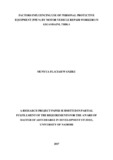| dc.description.abstract | Workers across industries are exposed to a variety of hazards at the workplace. The use of Personal Protective Equipment (PPE) is an important strategy for preventing exposure to hazards that could result in injuries and illnesses among workers across various industries including those in motor vehicle repair sector. This particularly applies more to workers in work environments where it may not be practical to adopt other hazard mitigation strategies due to various constraints. Despite the widely acknowledged benefits of PPE use, studies have shown that PPE use remains low, inconsistent and inappropriate. Studies conducted have concentrated more on utilization levels of PPE rather than determinants of use. This study therefore sought to identify factors that influence use of PPE. The study used both quantitative and qualitative techniques in data collection. The sample size was 140 participants constituting 80 survey respondents and 40 focus group discussion participants. Stratified sampling method was used to generate the survey sample while purposive sampling was used to select the focus group discussion participants. Data from the survey was complemented by information from focus group discussions that comprised workers involved in different motor vehicle repair activities. Responses from study respondents were analyzed using Statistical Package for the Social Sciences (SPSS) while information from key informants and focus group discussions was analysed thematically. Study findings showed that measures adopted by workers in protecting themselves from work related hazards presented according to emergent themes included ; use of personal protective equipment, use of correct tools, excising caution while working among others. Misconceptions on protective measures were noted such as the belief by panel beaters and spray painters that taking milk eliminates effects of exposure to sanding dust and spray fumes. Reasons for failure to use PPE identified by the study included unavailability due to cost implications, interference of the PPE with speed of work and comfort issues and the need to conform to what others were doing or not doing. Others felt the PPE was not necessary for their work, this could imply that workers were not aware of some of the risks posed by their work. PPE use among the workers was found to be suboptimal. The study found that there was an association between workers age, work experience, income and PPE use. The workers education level was not found to be associated with use of PPE. The study recommends that quality and affordable PPE to be availed in the market and safety and health awareness and education programs to be extended to workers in the informal motor vehicle repair sector so as to sensitize the workers on how they can ensure their own safety and the safety of others while at work. | en_US |



